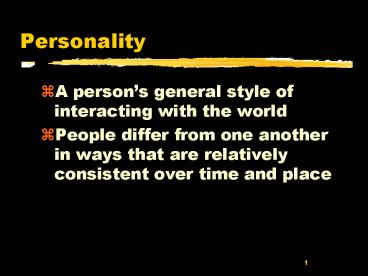Personality - PowerPoint PPT Presentation
1 / 19
Title:
Personality
Description:
People differ from one another in ways that are ... Karen Horney's focus on security. Object relations theories. Alfred Adler's individual psychology ... – PowerPoint PPT presentation
Number of Views:222
Avg rating:3.0/5.0
Title: Personality
1
Personality
- A persons general style of interacting with the
world - People differ from one another in ways that are
relatively consistent over time and place
2
Personality
- Psychoanalytic Approach Freudian Psychoanalysis
and Post-Freudian Theories
3
Psychoanalytic Approach
- Developed by Sigmund Freud
- Psychoanalysis is both an approach to therapy and
a theory of personality - Emphasizes unconscious motivation - the main
causes of behavior lie buried in the unconscious
mind
4
Psychoanalytic Approach
5
Psychoanalytic Approach
- Conscious - all things we are aware of at any
given moment
6
Psychoanalytic Approach
- Preconscious - everything that can, with a little
effort, be brought into consciousness
7
Psychoanalytic Approach
- Unconscious - inaccessible warehouse of
anxiety-producing thoughts and drives
8
Psychoanalytic Divisions of the Mind
- Id - instinctual drives present at birth
- does not distinguish between reality and fantasy
- operates according to the pleasure principle
- Ego - develops out of the id in infancy
- understands reality and logic
- mediator between id and superego
- Superego
- internalization of societys moral standards
- responsible for guilt
9
Defense Mechanisms
- Unconscious mental processes employed by the ego
to reduce anxiety
10
Defense Mechanisms
- Repression - keeping anxiety-producing thoughts
out of the conscious mind - Reaction formation - replacing an unacceptable
wish with its opposite
11
Defense Mechanisms
- Displacement - when a drive directed to one
activity by the id is redirected to a more
acceptable activity by the ego - Sublimation - displacement to activities that are
valued by society
12
Defense Mechanisms
- Projection - reducing anxiety by attributing
unacceptable impulses to someone else - Rationalization - reasoning away
anxiety-producing thoughts - Regression - retreating to a mode of behavior
characteristic of an earlier stage of development
13
Psychosexual Stages
- Freuds five stages of personality development,
each associated with a particular erogenous zone - Fixation - an attempt to achieve pleasure as an
adult in ways that are equivalent to how it way
achieved in these stages
14
Oral Stage (birth - 1 year)
- Mouth is associated with sexual pleasure
- Weaning a child can lead to fixation if not
handled correctly - Fixation can lead to oral activities in adulthood
15
Anal Stage (1 - 3 years)
- Anus is associated with pleasure
- Toilet training can lead to fixation if not
handled correctly - Fixation can lead to anal retentive or expulsive
behaviors in adulthood
16
Phallic Stage (3 - 5 years)
- Focus of pleasure shifts to the genitals
- Oedipus or Electra complex can occur
- Fixation can lead to excessive masculinity in
males and the need for attention or domination in
females
17
Latency Stage (5 - puberty)
- Sexuality is repressed
- Children participate in hobbies, school and
same-sex friendships
18
Genital Stage (puberty on)
- Sexual feelings re-emerge and are oriented toward
others - Healthy adults find pleasure in love and work,
fixated adults have their energy tied up in
earlier stages
19
Post-Freudian Psychodynamic Theories
- Karen Horneys focus on security
- Object relations theories
- Alfred Adlers individual psychology
- Erik Eriksons psychosocial development
- Carl Jungs collective unconscious































